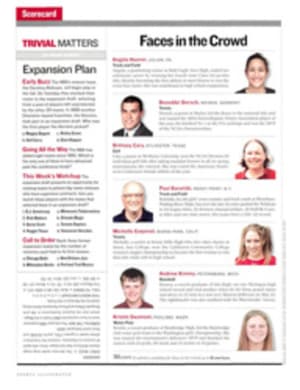
It's A Reel Whopper The annual Deep Sea Fishing Rodeo in Gulfport is the largest--and in some ways strangest--tournament of its kind
The scene was bizarre, colorful and teeming with life, a tableau
worthy of Faulkner. A crowd had gathered around a wheelbarrow
over which a hammerhead shark was ghoulishly draped. Nearby,
behind a metal barrier, sweat-soaked men, blood on their aprons,
wielded fillet knives against a mountain of fish. In the
background, against a threatening sky, a Ferris wheel spun, its
chimes tinkling through the thick noonday heat. At the center of
it all, under the roof of Gulfport's Bob Rice Pavilion, wide-eyed
children and grinning adults formed a serpentine line in front of
a 70-foot-long bin of ice that displayed all manner of sea
creatures, visual testimony to the diversity found in the waters
in and around Mississippi's Gulf Coast.
The creatures came in all shapes, sizes and colors: bluefish,
blackfish, red snapper and green trout (the local name for
largemouth bass). Sheepshead, oyster dogs, catfish and alligator
gar. Stingray, flounder and purplemouth moray eel. "We give
prizes for 22 categories of saltwater species, and six
freshwater," said Chuck Dedeaux, president of the Mississippi
Deep Sea Fishing Rodeo, which will celebrate its 56th anniversary
from July 1 to 4. "A lot of work's involved, all by volunteers,
but it's fun. We put up a stage, hire entertainment and try to be
as family oriented as we can."
The event bills itself as the "world's largest fishing rodeo,"
and starting at 12:01 a.m. on the first day, as many as 5,000
entrants from a dozen or more states head to their favorite
fishing holes in Mississippi's bayous, ponds, lakes, rivers,
flats, barrier islands and beyond, into the deep water of the
Gulf of Mexico, to compete for the titles of King Fisherman and
Queen Fisherette. Just about anything that bites is fair game,
which leads to a wild assortment of piscatorial bounty, from the
one-pound, 10-ounce bluegill that helped Charles Hilburn of
Lucedale, Miss., collect the $500 check as King Fisherman in the
Freshwater Division in 2003, to the 176-pound, 12-ounce
hammerhead caught by Gulfport's own Sherry Deshamp, who won $500
for being Queen Fisherette, Saltwater Division, for the fourth
straight year.
All entries must be caught by rod and reel--the only exception is
flounder-gigging, which employs a kind of spear--and when the
fish is brought to weigh in, it must be fit for human
consumption. It also can't have been frozen, stuffed with lead
sinkers or shot full of fruit juice. "When redfish have been dead
awhile, they lose the reddish tint around their eyeballs," says
George Wright, a former weighmaster who worked for 30 years as a
conservation officer for the state Department of Wildlife,
Fisheries and Parks. "Fishermen have been known to inject the
eyeball with cranberry juice to make it look fresh. A weighmaster
has to feel the fish, smell it and check its flexibility. We've
had some close calls over the years where the fists almost flew."
At stake? Bragging rights and some $50,000 in cash and prizes,
with a special award given for the most unusual fish. In 2003
that went to Tommy Williams of Roswell, Ga., who while fishing
for red snapper out by the oil rigs caught a rare and
surpassingly ugly creature called Ruvettus pretiosus, or oil
fish.
The origins of the rodeo date to World War II, when Gulfport
charter boat captains, lacking clients, were enlisted by the
Coast Guard to help patrol the Mississippi Sound and the Gulf of
Mexico for German submarines, which lay offshore preying on
merchant ships leaving New Orleans. While not searching for
periscopes, boat captains killed time by placing friendly wagers
to see who could catch the biggest fish in various categories.
Mississippi's Gulf Coast, with its diverse habitat, is home to a
wide variety of species, from deepwater game fish like dolphin,
king mackerel and cobia, to coastal feeders like redfish,
flounder, tarpon and black drum that thrive in the brackish water
near the mouths of the Biloxi and Pascagoula rivers. A chain of
barrier islands 12 miles off the coast protects the sound from
offshore winds, creating a giant bay that's seldom deeper than 10
feet. It abounds with sharks, speckled trout and flounder. Taken
as a whole, the waters around Gulfport are a sportfishing
paradise.
After the war the city's American Legion post decided to continue
the tradition of the captains' informal tournament by starting a
full-fledged competition, and in 1948 it staged the first Deep
Sea Fishing Rodeo. By 1958 the event was so large and costly that
the legion handed it over to a nonprofit organization of civic
leaders from communities in and around the Gulf Coast that runs
it to this day. Festivities include fireworks, a carnival, a
beauty pageant and celebrity appearances.
But the fish have always been the stars. In 1983 Bruce Bartling
of Jackson, Miss., caused a sensation when he brought in a tiger
shark that was so big it couldn't be weighed on the scale at the
dock. A crowd formed, and when a radio station got wind of the
story, cars began descending on the pavilion, bringing traffic to
a standstill. The creature finally had to be cut in three pieces
to be weighed. It still holds the state record for largest shark:
885 pounds.
Most of the fish brought in are either served to volunteers or
given away to charities. Others are attacked by marine biologists
wielding microscopes and scalpels. "A tournament like this is
like a candy shop for a scientist," says Ash Bullard, a graduate
student at the Gulf Coast Research Laboratory, who at the 2003
event was collecting parasites for work on his Ph.D. "It's nice
that some good is coming out of this carnage. Tournaments like
this are not going to be around very much longer."
Indeed, fishermen who believe in catch-and-release blanch at the
sight of the rodeo's catch bin, which at any given time might
hold hundreds of fish. Most biologists agree, however, that the
fish population in the waters off Mississippi is stable enough to
survive the annual event.
"This is the only place I can get my hands on an alligator gar,"
says state fisheries biologist Dennis Riecke, describing one of
the strangest fish of the estuaries and bayous. "We don't know
very much about them. They're an ancient species, one of the
first fish to have bones. They have scales like armor--Indians
used them for arrowheads."
And so Riecke returns to Gulfport annually, drawn with the
thousands of others who come to eat, compete, dissect--or just
gawk at species many have never seen before. "That's why we're
here," says Riecke. "This tournament has the biggest variety of
fish anywhere around."
SI.com
For more about sports in Mississippi and the other 49 states, go
to si.com/50.
COLOR PHOTO: PHOTOGRAPHS BY BILL FRAKES ROYAL DUTIES Chelsea Diane Welch, queen of the 2003 rodeo, showed off a massive king mackerel at last year's event.
COLOR PHOTO: PHOTOGRAPHS BY BILL FRAKES HOOK, LINE AND SINGER The once informal competition has grown into a major holiday attraction.
THREE COLOR PHOTOS: PHOTOGRAPHS BY BILL FRAKES PICKIN'S OF THE SEA Rodeo anglers pull in dozens of species each year, from the familiar striped bass (left) and blue runner (above, right) to the rare alligator gar.
"A tournament like this is a candy shop for a scientist," says
one researcher. "It's nice that some good is coming out of this
carnage."

